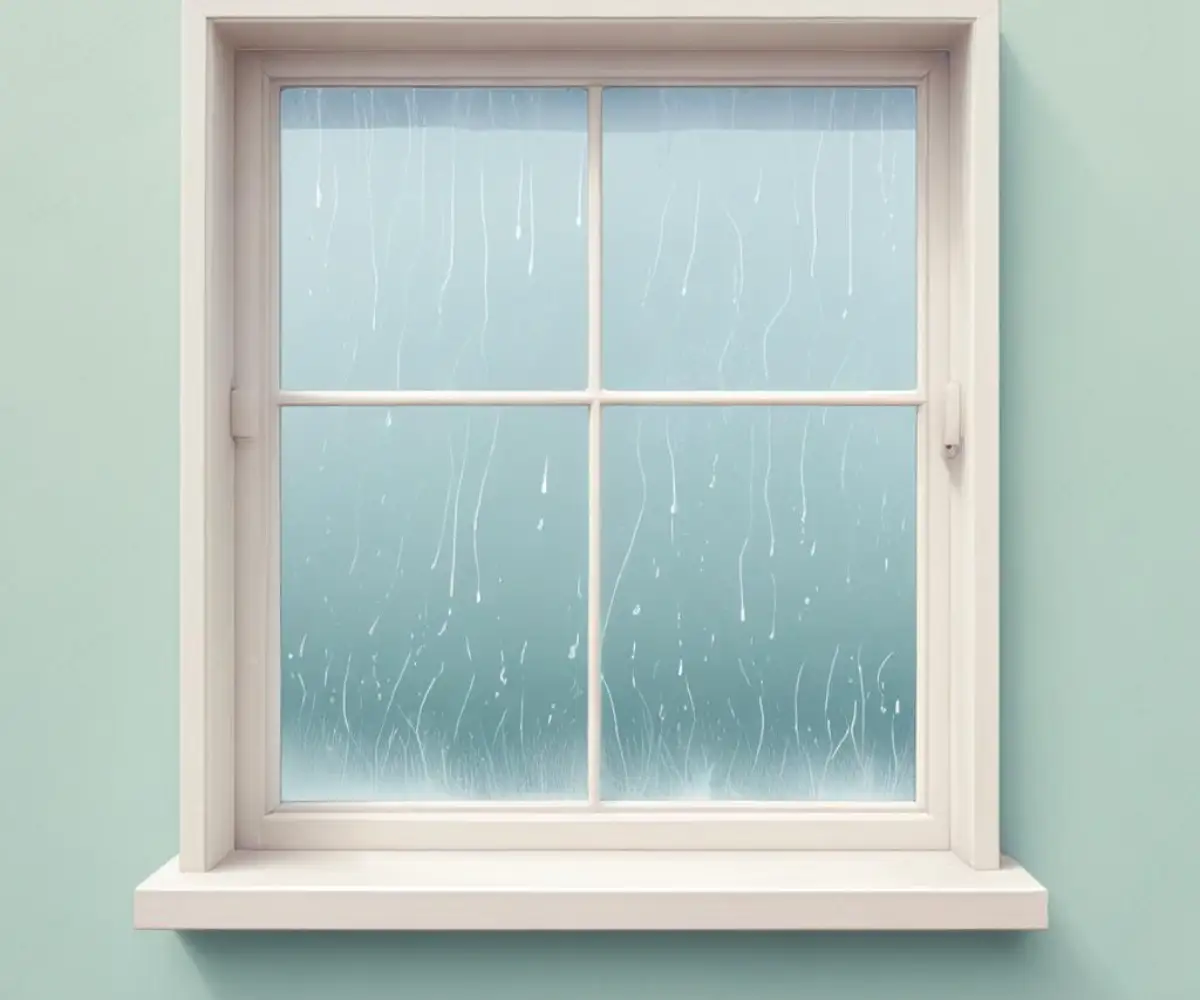Streaks Inside Double Pane Windows? Here’s the #1 Cause & Fix
There’s nothing more frustrating than cleaning your windows only to find that ugly streaks remain. You scrub the outside, you scrub the inside, but the hazy lines don’t budge. That’s because the problem isn’t on a surface you can reach; it’s deep inside your double-pane window.
These streaks are more than just a visual annoyance. They are a clear signal that your window is no longer performing its job, and ignoring the issue can lead to bigger problems down the line. Understanding the cause is the first step toward a permanent solution.
You'll Learn About
What Really Causes Those Ugly Streaks Between Window Panes?
The streaks you see are the ghostly leftovers of moisture that has gotten trapped between the two panes of glass. This happens for one primary reason: a broken or failed window seal. Your double-pane window, also known as an Insulated Glass Unit (IGU), is a sophisticated system designed for energy efficiency.
It consists of two panes of glass separated by a spacer and hermetically sealed around the edges. The space between the panes is typically filled with a dense, inert gas like argon or krypton, which insulates far better than regular air. When this airtight seal fails, the entire system breaks down.
The process begins when the seal degrades due to age, sun exposure, or physical stress. This allows the insulating gas to leak out and, crucially, allows moisture-laden air to seep in. As the window heats up and cools down, this trapped moisture condensates on the inner glass surfaces, and when it evaporates, it leaves behind mineral deposits and residue, forming the streaks you can’t wipe away.
The Unseen Science: Thermal Pumping
A little-discussed factor that accelerates this process is “thermal pumping.” During a sunny day, the air and gas inside the sealed unit heat up and expand, putting outward pressure on the glass and seals. At night, the unit cools and contracts, creating an inward-pulling, or negative, pressure.
Over thousands of these cycles, this constant flexing action, much like bending a paperclip back and forth, weakens the window’s seals. A healthy seal can withstand this for decades, but an aging or defective one will eventually fail, “breathing” in moist air every time it cools down.
Can You Clean the Inside of a Double-Pane Window?
This is one of the most common questions homeowners have, and the answer is definitive. No, you cannot clean the inside of a sealed double-pane window unit. The unit is manufactured to be a permanently sealed system. There is no safe or effective way to get between the panes of glass to wipe away the streaks.
Some companies offer “de-fogging” services, which involve drilling small holes into the glass, spraying a cleaning solution inside, and then attempting to reseal the holes with a valve. This is a temporary cosmetic fix at best. It does not remove all the mineral deposits, fails to restore the insulating argon gas, and often allows even more moisture and dust to enter the unit over time, making the problem worse.

Your Action Plan: How to Permanently Fix Streaks in Double-Pane Windows
Since cleaning is not an option, the only real solution is to replace the compromised part of the window. Fortunately, this doesn’t always mean you need to tear out the entire window frame and start from scratch. You have three main options, ranging in cost and complexity.
Solution 1: IGU (Insulated Glass Unit) Replacement
This is often the most practical and cost-effective solution. IGU replacement involves ordering a new, custom-made sealed glass unit and swapping it into your existing window frame. A glazing professional removes the stops holding the old, streaky glass unit, sets the new one in place, and secures it.
This approach is ideal when your window frames (the vinyl, wood, or fiberglass structure) are still in good condition. You get a brand-new, efficient glass unit, restoring your view and insulation without the cost and disruption of a full window replacement.
Solution 2: Replacing the Window Sash
The “sash” is the part of the window that holds the glass and moves up and down or cranks out. A sash replacement involves swapping out this entire moving part. It comes from the factory with the new IGU already installed in it.
This is a great option if the sash frame itself is also showing signs of wear, such as rot, warping, or cracking, in addition to the streaky glass. When considering this, it’s wise to understand the differences in options, as covered in a deep dive on sash kits vs replacement windows. It’s more involved than just an IGU swap but less so than a full replacement.
Solution 3: Full Window Replacement
This is the most comprehensive and expensive option. A full window replacement is necessary when the entire window system—frame and all—is failing. Signs that you need a full replacement include significant frame rot or damage, windows that are difficult to operate, or a desire to upgrade to a completely new style or more energy-efficient model.
While it is a larger investment, it can significantly improve your home’s energy efficiency, comfort, and curb appeal. It is the go-to solution when the problem extends far beyond just the glass.
Choosing the Right Solution: A Comparison
Making the right choice depends on your budget, the condition of your existing windows, and your long-term goals. The table below breaks down the key factors for each option to help you decide.
| Feature | IGU Replacement | Sash Replacement | Full Window Replacement |
|---|---|---|---|
| Average Cost | Low | Moderate | High |
| Labor Intensity | Low to Moderate | Moderate | High |
| Best For… | Streaky or foggy glass in an otherwise healthy window frame. | Failed glass combined with a damaged or rotting window sash. | Damaged frames, poor operation, or a full home efficiency upgrade. |
| Insulation Restored? | Yes, the new glass unit restores full R-value. | Yes, the new sash and glass restore full efficiency. | Yes, often provides an upgrade in overall efficiency. |
| Frame Condition | The existing frame must be in good, solid condition. | The main window frame must be sound, but the sash can be damaged. | The entire existing window system can be failing. |
Proactive Measures: How to Prevent Future Window Seal Failure
Once you’ve fixed your streaky windows, you’ll want to ensure the replacements last as long as possible. While all seals will eventually fail, you can take steps to maximize their lifespan and protect your investment.
First, ensure your windows are installed correctly. A poor installation can put uneven pressure on the frame and IGU, leading to premature seal failure. Also, perform regular inspections of the seals and caulking around your windows, addressing any cracks or gaps before water can penetrate.
It is also vital to keep the small drainage channels at the bottom of the window track, known as weep holes, clear of debris. These holes are designed to let water escape, and if they are clogged, water can pool against the window seal, accelerating its degradation. Lastly, avoid using a high-pressure power washer directly on window glass and seals, as the force can damage the seal.
The Humidity Factor You’re Ignoring
Many homeowners don’t realize that high indoor humidity creates a constant vapor pressure pushing outward on their windows. Over time, this pressure can stress the seals, especially in rooms like bathrooms and kitchens. Proper ventilation is key to managing this.
Using exhaust fans is a start, but for larger spaces or whole-house humidity issues, ensuring good air circulation is essential. In some cases, a tool as simple as a powerful fan can help manage airflow and reduce the strain on your windows. For homes with very large casement or slider windows, finding a powerful fan can be a challenge, which is where a specialized widest window fan can make a significant difference in circulating air effectively.
Beyond the Streaks: Hidden Dangers of a Failed Window Seal
Those streaks are just the visible symptom of a deeper problem. A failed window seal carries several hidden consequences that can affect your home’s health, comfort, and budget.
The most significant impact is dramatic energy loss. The argon or krypton gas that leaked out is replaced by air, which is a poor insulator. Your window’s ability to resist heat transfer (its R-value) plummets, meaning your HVAC system has to work harder to keep your home comfortable, leading to higher energy bills year-round.
Furthermore, the trapped moisture can create a perfect breeding ground for mold and mildew between the panes. This is not only unsightly but can also pose a health risk for individuals with allergies or respiratory issues. This is a particularly common issue in enclosed spaces with many windows, where replacing damaged units with proper sunroom replacement panels is critical to maintaining a healthy environment.
A Special Note on Window Film and Seal Failure
Here is a critical piece of advice many people overlook. Applying dark, heat-absorbing tint or solar film to an older double-pane window can be the final straw that causes its seal to fail. The dark film increases the temperature of the glass, causing a more extreme expansion and contraction cycle (thermal stress).
If the window seal is already aged and brittle, this added stress can be enough to break it. If you plan to apply window film, it’s best to do so on newer, healthy windows and check the window manufacturer’s warranty, as some may void coverage if films are applied.
Don’t Live With Streaky Windows
In conclusion, streaks inside your double-pane windows are an unmistakable sign that the hermetic seal has failed. This is not a problem you can clean away; it requires replacing the compromised glass unit.
Ignoring it means living with a poor view, higher energy bills, and potential moisture issues. By assessing the condition of your window frames, you can choose the most effective solution, whether it’s replacing the IGU, the sash, or the entire window.
Take action to consult with a window professional. You can restore your clear view, improve your home’s energy efficiency, and protect your investment for years to come.

